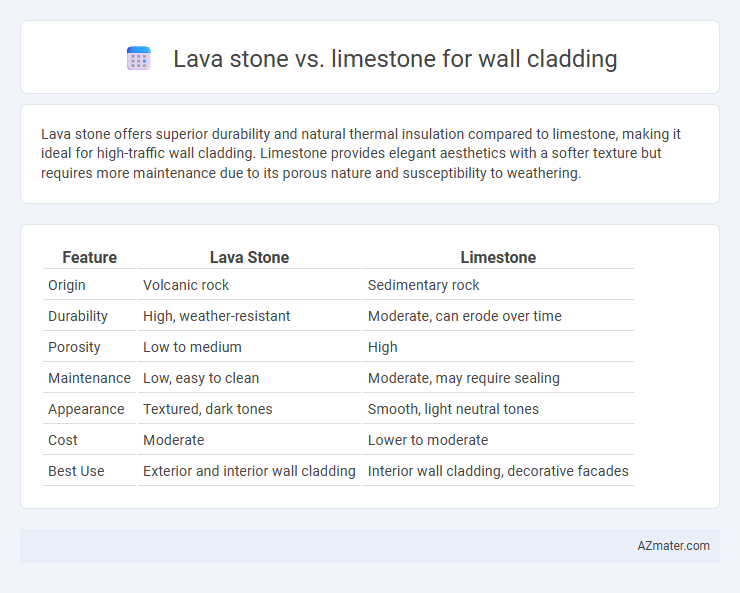Lava stone offers superior durability and natural thermal insulation compared to limestone, making it ideal for high-traffic wall cladding. Limestone provides elegant aesthetics with a softer texture but requires more maintenance due to its porous nature and susceptibility to weathering.
Table of Comparison
| Feature | Lava Stone | Limestone |
|---|---|---|
| Origin | Volcanic rock | Sedimentary rock |
| Durability | High, weather-resistant | Moderate, can erode over time |
| Porosity | Low to medium | High |
| Maintenance | Low, easy to clean | Moderate, may require sealing |
| Appearance | Textured, dark tones | Smooth, light neutral tones |
| Cost | Moderate | Lower to moderate |
| Best Use | Exterior and interior wall cladding | Interior wall cladding, decorative facades |
Introduction to Wall Cladding Materials
Lava stone offers exceptional durability and heat resistance for wall cladding, making it ideal for both interior and exterior applications with a volcanic texture that enhances visual appeal. Limestone provides a softer, natural look with excellent insulation properties but requires more maintenance due to its porosity and susceptibility to weathering. Selecting between lava stone and limestone depends on desired aesthetic, environmental conditions, and long-term durability needs.
Understanding Lava Stone: Features and Origins
Lava stone, formed from rapidly cooled volcanic lava, offers exceptional durability, natural heat resistance, and a porous texture ideal for wall cladding. Its origins trace back to volcanic regions such as Italy's Mount Etna and Indonesia's volcanic islands, where mineral-rich compositions create unique dark hues with rugged, textured surfaces. Unlike limestone, lava stone resists moisture and weathering better, making it a preferred choice for both interior and exterior wall cladding applications.
Limestone: Composition and Characteristics
Limestone for wall cladding is primarily composed of calcium carbonate (CaCO3), often formed from compacted marine organisms, giving it a dense yet porous texture. Its soft, sedimentary nature allows for easy cutting and shaping, while its natural range of creamy white to warm beige tones enhances aesthetic versatility. Limestone exhibits excellent durability and weather resistance, making it ideal for both interior and exterior cladding applications where a timeless, elegant appearance is desired.
Aesthetic Differences: Texture and Color
Lava stone offers a rugged, porous texture with deep blacks, grays, and occasional rusty reds, creating a dramatic and natural aesthetic for wall cladding. Limestone provides a smoother, more refined surface with subtle, neutral tones ranging from creamy whites to soft beiges, resulting in a classic and elegant appearance. The choice between lava stone and limestone depends on whether a bold, rustic ambiance or a clean, sophisticated look is desired.
Durability and Longevity Comparison
Lava stone offers superior durability and resistance to weathering compared to limestone, making it an ideal choice for wall cladding in harsh environmental conditions. Limestone, while aesthetically pleasing and easier to work with, is more susceptible to erosion and chemical weathering, which can reduce its longevity over time. For long-lasting wall cladding, lava stone provides enhanced structural integrity and minimal maintenance requirements.
Weather Resistance and Maintenance
Lava stone offers superior weather resistance compared to limestone due to its volcanic origin, making it highly resistant to moisture, temperature fluctuations, and erosion, which ensures longevity for exterior wall cladding. Limestone is more porous and prone to weather-related wear, requiring regular sealing and maintenance to prevent staining, cracking, and water infiltration. Choosing lava stone reduces the frequency of maintenance tasks, while limestone demands ongoing care to preserve its appearance and structural integrity in exposed environments.
Installation Process and Cost Factors
Lava stone wall cladding requires careful handling due to its porous and brittle nature, often needing specialized adhesives and mechanical fixing methods, which can increase installation complexity and labor costs. Limestone cladding is easier to cut and install with standard tools, generally reducing labor time and installation expenses. Cost factors for lava stone include higher transportation and preparation costs, whereas limestone offers a more budget-friendly option with moderate durability and maintenance needs.
Environmental Impact and Sustainability
Lava stone offers superior environmental benefits for wall cladding due to its natural origin from volcanic rock, exhibiting high durability and low maintenance, which reduces resource consumption over time. Limestone extraction often involves significant quarrying and energy-intensive processing, leading to higher carbon emissions and ecosystem disruption. Opting for lava stone supports sustainable building practices by minimizing environmental impact and promoting long-lasting, eco-friendly construction materials.
Best Applications for Lava Stone and Limestone
Lava stone, known for its high durability and heat resistance, is ideal for exterior wall cladding in harsh weather conditions and modern architectural designs requiring a rugged, textured appearance. Limestone offers excellent thermal insulation and a smooth, elegant finish, making it perfect for interior wall cladding in residential and commercial spaces seeking a classic, timeless aesthetic. Both materials provide unique benefits, with lava stone excelling in outdoor applications and limestone preferred for indoor environments where aesthetic refinement and temperature control are priorities.
Choosing the Right Material: Key Considerations
Lava stone offers exceptional durability and natural heat resistance, making it ideal for exterior wall cladding in harsh climates, while limestone provides a classic aesthetic with its softer texture and subtle color variations, suitable for both interior and exterior applications. Consider the environment, maintenance requirements, and long-term durability; lava stone withstands weathering and erosion better, whereas limestone requires more care to prevent staining and degradation. Weight and installation complexity also play a role--lava stone is denser and heavier, influencing structural support needs, whereas limestone is easier to cut and shape for intricate designs.

Infographic: Lava stone vs Limestone for Wall cladding
 azmater.com
azmater.com